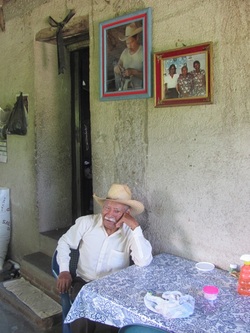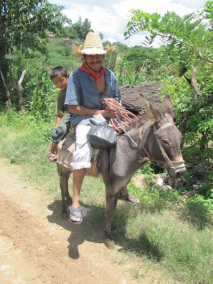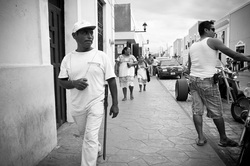DON PRIMITIVO - PART DOS

Many times over the years I searched the internet for Don Primitivo, hoping to learn something of him or his machetes. There was nothing, though. Eventually I found that both Guerrero and Cualac had websites and they claimed to be famous for their engraved machetes! There was a phone number listed for the municipal building in Cualac, so I called. “Yes, Don Primitivo is still living here.” “He is not working at the forge anymore, but his son sometimes makes machetes. No, No one else in Cualac makes them anymore.” I decided to go and visit Don Primitivo again.
I sent a letter and some photos to Don Primitivo – but got no response. So, in 2011, I planned a trip to Cualac – fly from Merida to Mexico City, then by car south into Guerrero and through the mountains to Cualac. Everyone warned of the dangers of traveling in the mountains of Guerrero – bandits and kidnappers! Stay off the roads at night, don’t carry anymore cash than you need, leave valuables at home, keep the doors locked, don’t stop for anything… not for food, water or el bano. The same warnings as in 1980!
It was supposed to be an eight hour drive from Mexico City, but by the time we rented a car and got out of DF it was mid-afternoon. Knowing to be off the road by dark, we stopped in Cuernavaca for the night and set out again at dawn.
I sent a letter and some photos to Don Primitivo – but got no response. So, in 2011, I planned a trip to Cualac – fly from Merida to Mexico City, then by car south into Guerrero and through the mountains to Cualac. Everyone warned of the dangers of traveling in the mountains of Guerrero – bandits and kidnappers! Stay off the roads at night, don’t carry anymore cash than you need, leave valuables at home, keep the doors locked, don’t stop for anything… not for food, water or el bano. The same warnings as in 1980!
It was supposed to be an eight hour drive from Mexico City, but by the time we rented a car and got out of DF it was mid-afternoon. Knowing to be off the road by dark, we stopped in Cuernavaca for the night and set out again at dawn.

Burrito - Cualac 2011
_The road south to Chilpancingo was a four lane toll road, high speed for
two hours or so, then east through lush valleys and over the sierra,
through small pueblos and a couple of larger towns. We arrived in
Olinala around 4 pm, and after lunch set out on the old dirt road from
Olinala to Cualac, a 20 kilometer drive. By this time, there was not
much daylight left and the sky was threatening rain. We figured we
could make it and find a place for the night in Cualac. As we
maneuvered the car from side to side along the dirt track to avoid
holes, rocks and deep ruts, the sky became darker and the clouds more
threatening – lightening bolts were striking the mountains, a heavy rain
was approaching. A man on horseback coming from the direction of
Cualac told us that if we drove very fast we might make it (impossible
of course in our Scala sedan on a dirt road). So we turned around and
arrived back in Olinala with a torrential rain that lasted most of the
night. We found a room and a meal and headed out early the next
morning. The dirt road to Cualac seemed drivable and we made it as far
as a small stream crossing – it’s usually a small stream crossing, but
the rains had created a river that could have easily swept away the
Scala. So back through Olinala again to find the new road into Cualac.
The new road starts fairly high up in the mountains and descends into Cualac. It was worse than the old dirt road! It was an obstacle course of rock and mudslides as well as collapsed roadway that fell away down the mountainside. Every heavy rain had caused the mountain to send down mud and rocks from above and to eat away the blacktop from below. It's almost as if the mountain is trying to rid itself of the scars cut into its side by the road builders. Small crews of men and young boys come out after the rains with shovels and wheel barrows to clear the road and ask the passing cars for a few pesos
Once down the mountain we were in a lush valley. We crossed a small stream and entered Cualc. Unlike in 1980, the narrow streets are paved, and there are now two story cement houses, not just the low thatch or tile roofed adobe buildings I remembered. We found the town square and stopped at the municipal building. A man approached and said “Hello, how are you?” ‘Muy bien” I answered “y tu?”. He had spent about twenty years working in California, and yes, of course he knew Don Primitivo and would be happy to show us the way.
The new road starts fairly high up in the mountains and descends into Cualac. It was worse than the old dirt road! It was an obstacle course of rock and mudslides as well as collapsed roadway that fell away down the mountainside. Every heavy rain had caused the mountain to send down mud and rocks from above and to eat away the blacktop from below. It's almost as if the mountain is trying to rid itself of the scars cut into its side by the road builders. Small crews of men and young boys come out after the rains with shovels and wheel barrows to clear the road and ask the passing cars for a few pesos
Once down the mountain we were in a lush valley. We crossed a small stream and entered Cualc. Unlike in 1980, the narrow streets are paved, and there are now two story cement houses, not just the low thatch or tile roofed adobe buildings I remembered. We found the town square and stopped at the municipal building. A man approached and said “Hello, how are you?” ‘Muy bien” I answered “y tu?”. He had spent about twenty years working in California, and yes, of course he knew Don Primitivo and would be happy to show us the way.
_I had remembered his house as being isolated, surrounded by land and
trees, almost like a small ranch, with a wide porch and an open view.
But now, it’s surrounded by other houses. We entered through the iron
gate and introduced ourselves to the woman who came out of the house, a
daughter-in-law as it turned out. She went back inside and came out with a
woman who remembered me from my visit. She was a young girl then, about
14. Sara welcomed us and said that Don Primitivo was up in the campo
and she would lead us up there. But as soon as we stepped out onto the
street, there was Don Primitivo walking down from the campo, machete in
hand, returning for lunch and a siesta!
Don Primitivo seemed very happy that I had returned, not only to see him, but also that I came to live in Mexico and make knives once more. He said he thought about me often, but didn't think he'd ever see me again. I told him that I had been thinking of him for the last 30 years and had been hoping to come back.
Don Primitivo is eighty-five now. His wife died about fifteen years ago, and the son I met in 1980 lives in Acapulco now, along with Don Primitivos brother. Another son, in his early 40's, still makes machetes when he can. He lives nearby with his wife and children and still works the family land and tends the animals.
Don Primitivo was in a reflective mood and talked about his life. He told us that when he was ten, some men had killed his father and had also planned to kill him. An aunt hid him with a priest, who in turn sent him to Ayutla. In Ayutla he was apprenticed to a machete maker, learned his trade well and became a master himself. Don Primitivo told us how he would make a dozen or so knives and machetes, then pack them on his burrito and walk through the mountains to the market in Tlapa to sell them. He reminisced about a man (an olympic gold medalist he said) who came from Mexico City one day looking for machetes and introduced him to FONART, which led to him selling machetes all over Mexico. Don Primitivo was very proud of the reputation he had for his fine work. And especially proud of how he engraved his blades with a hammer and chisel, rather than the more common method of acid etching.
Don Primitivo stopped working at the forge a few years ago when his eyesight started failing. His son still makes machetes occasionally but had nothing to show us the day we were there. He would like to carry on his father’s work, but he has no one to help him at the forge or with the land. When Don Primitivo was making machetes, his brother helped as a striker (following Don Primitivos light hammer blows with a heavy sledge) and his son or another young man would work the leather bellows. Now, many young men have left Cualac to seek work in the cities or in the US.
Don Primitivo seemed very happy that I had returned, not only to see him, but also that I came to live in Mexico and make knives once more. He said he thought about me often, but didn't think he'd ever see me again. I told him that I had been thinking of him for the last 30 years and had been hoping to come back.
Don Primitivo is eighty-five now. His wife died about fifteen years ago, and the son I met in 1980 lives in Acapulco now, along with Don Primitivos brother. Another son, in his early 40's, still makes machetes when he can. He lives nearby with his wife and children and still works the family land and tends the animals.
Don Primitivo was in a reflective mood and talked about his life. He told us that when he was ten, some men had killed his father and had also planned to kill him. An aunt hid him with a priest, who in turn sent him to Ayutla. In Ayutla he was apprenticed to a machete maker, learned his trade well and became a master himself. Don Primitivo told us how he would make a dozen or so knives and machetes, then pack them on his burrito and walk through the mountains to the market in Tlapa to sell them. He reminisced about a man (an olympic gold medalist he said) who came from Mexico City one day looking for machetes and introduced him to FONART, which led to him selling machetes all over Mexico. Don Primitivo was very proud of the reputation he had for his fine work. And especially proud of how he engraved his blades with a hammer and chisel, rather than the more common method of acid etching.
Don Primitivo stopped working at the forge a few years ago when his eyesight started failing. His son still makes machetes occasionally but had nothing to show us the day we were there. He would like to carry on his father’s work, but he has no one to help him at the forge or with the land. When Don Primitivo was making machetes, his brother helped as a striker (following Don Primitivos light hammer blows with a heavy sledge) and his son or another young man would work the leather bellows. Now, many young men have left Cualac to seek work in the cities or in the US.

Man With Machete - Valladolid. Photo by James Maher
_The machete is still a ubiquitous tool in
Mexico. When out in the countryside, you can see men on horseback or
burro with a machete strapped to the saddle, and men walking out of the
woods with a machete in their hand. But they are the products of
factories and not artesanos. The market for hand made machetes today is
with collectors, and Cualac is very isolated from the world of
collectors - I asked Don Primitivo if he received the letter and
pictures I sent months earlier and was told that mail is not delivered
there. There is no access to computer either, so no access to
information. There is a phone in the municipal office - Don Primitivo's
son can receive incoming calls, but who would he call? He was very
interested in my tools and machines, so I showed him pictures of my
workshop. I think with a power hammer and a grinder he could be very
productive working on his own.
I’m going to see if I can help him continue the tradition of handcrafting machetes in Mexico.
I’m going to see if I can help him continue the tradition of handcrafting machetes in Mexico.


